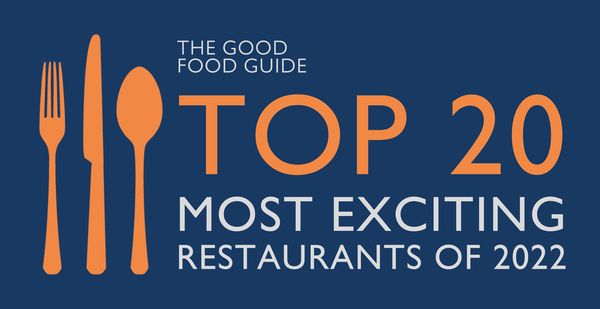Gordon Ramsay in The Good Food Guide 1995
This stylish, exuberant newcomer deals in contemporary French food. The small room is inviting, open and airy: a pale, creamy sunny yellow, with striking flowers and large tables generously spaced. Even on a weekday evening Aubergine can have an electric atmosphere. It is significant that many reporters refer to the chef with whom Gordon Ramsay has worked – Marco Pierre White and Albert Roux in London, Joël Robuchon and Guy Savoy in Paris – spotting dishes that make reference to his mentors. But Ramsay is now beginning to develop a style of his own.
‘It isn’t cuisine du terroir but it keeps its feet on the ground’ was one punning comment. Freshness and flavour appear centre stage, and Ramsay avoids the fanciful posing gestures that bedevil many of today’s prima donna chefs. People go to enjoy his food, and they report favourably on a long list of dishes that include parfait of duck foie gras with toasted brioche, a standard of the repertoire perhaps, but done with consummate skill, fine textured and full of flavour. The lightness of touch is appreciated in, for example, a raviolo of salmon mousse: floating in a fine asparagus bouillon on one occasion, served with five-spice vinaigrette on another – ‘a dish of glad, confident vivacity and real invention’.
[…] The exciting thing is that Ramsay has plenty more potential packed away waiting to reveal itself. Aubergine has the makings of a real star.
Gordon Ramsay in The Good Food Guide 1996
It is very difficult to get in, wrote one reporter. Having failed once, 'the following day I tried it in French and got a table'. Although the chef was born in Scotland, Aubergine is really a modern French restaurant, whose popularity may seem surprising, given that brasseries seem to hold all the fashionable aces at the moment. But 'the food is complex, looks sensational, and flavour is paramount. Prices may have crept up since last year, but that was only to be expected of a restaurant with a waiting-list for every meal-time. Renovation at the beginning of 1995 improved its attraction; warm colours, discreet lighting, wooden floors, screens and mirrors produce a feeling of both space and privacy.
Despite its popularity, this is not just a place where all the year's fads fetch up, although it does go into frothy cappuccino mode quite a bit, whether using the brew as a sort of non-alcoholic aperitif or as a way of making sauces appear ultra-light. ‘In my opinion his cappuccino of roasted langoustines will become famous for its intensity and lightness,' predicted one. Intensity and lightness are certainly hallmarks of the style, and are particularly apparent in fish. Ravioli of lobster is served with baby spinach and a ginger cream, fillet of roasted John Dory comes with a cream of peas, while choucroute of fish is a vehicle for presenting the day's trawl from the market, and for showing off accurate cooking. Other successes have included mackerel with lime and coriander, and 'well-balanced and subtle' roasted sea bass with vanilla sauce.
Some may wonder about such fine points as whether the repertoire is developing, or whether the food has acquired its own confident identity, but there is no doubt that it pleases a large number of reporters. Wonderful fish, oils, salads and vegetables are offset off with just enough luxury from foie gras, lobster and wild mushrooms, and the cooking works equally well with a plain, understated dish of pigeon, the breasts in a light stock, the legs on a roundel of spinach, as with a tortellini of ratatouille in a buttery tomato sauce. Flavours can be bold, but are well controlled. Among puddings, pistachio soufflé has been brilliant', prune and armagnac ice-cream is exemplary, and the same process of slow roasting that brings out intense flavours in, say, tomatoes, also works for strawberries, slices of which at one meal added a vivid edge to a crème brûlée.
Food of this quality deserves a no-smoking area, and some may find it surprising that women are handed menus without prices. The three-course lunch is considered 'terrific value for money'. Staff can get carried away with
their own enthusiasm, but this is the acceptable face of Gallic service: 'charming,
helpful and informative'. The same wine waiter who will treat you to a rapturous account of the exotic fruit flavours in a New Zealand Sauvignon Blanc will also point out that the vintage has changed and recommend 'an improbably good Pinot Noir to accompany our awkward range of main courses'. France naturally dominates the list, and there are some good vintages in the right places, but mark-ups are on the high side. House French is £15, and ten wines are available by the glass from £4 to £8.
Gordon Ramsay in The Good Food Guide 1998
Is it only five years since Gordon Ramsay opened Aubergine in genteel and affluent Chelsea? It will be in 1998, although the amount of press coverage he attracts makes it feel like much longer. Modestly sized, but colourful and cheering thanks to distressed yellow walls and bright landscape paintings, the restaurant is hugely popular: ‘we got in quite easily by booking about two months in advance’. The à la carte is a journey through luxury ingredients – lobster, foie gras, scallops, langoustines – some of them integrated into Ramsay’s signature pasta formats of tortellini, ravioli and the like. Nothing is straightforward, as dishes undergo a multitude of layering, wrapping, frothing and stuffing before finally being plated. Despite the fuss, ‘some of it pretentious’, the food is resoundingly confident.
The impact of forthright flavours kicks in from the word ‘go’, perhaps with an appetiser of vichyssoise soup, and then the fireworks begin. Foie gras cooked three ways is ‘theatrical’: a small terrine, a half-cooked disc in a small ramekin of slightly underwhelming Earl Grey jelly, and a fiercely seared nugget sitting on a bed of stewed fig (the combination of charred surface, rich liver, and sweet fruit proves ‘mind-blowing’ for one reporter). Attractive presentation goes hand in hand, as in generously filled ravioli of lobster and langoustine, with ‘savoury back-up’ from fennel purée and rosemary jus ‘artistically drilled in circles around the plate’.
Given the complexity of some dishes, consistency – even on a single plate – can be difficult to control. But among the highlights of an inspection lunch was a pot au feu of Bresse pigeon: two ‘magnificent, juicy, soft’ breasts poached in a court bouillon, served with ceps and ‘a garden full of vegetables’.
[…] Service is helpful, enthusiastic and attentive, ‘accents are straight from “Allo Allo”’, and the sommelier is praised for his knowledge and tact. Wines make all the right noises, mostly French. Aristocratic claret and burgundy head up the lengthy list, but lesser regions are also featured and the New World makes a few notable contributions. Prices are high, like the quality, but some wines under £20 can be found, including the house French at £15.
Gordon Ramsay in The Good Food Guide 2000
On the surface, it seems that nothing has changed. The dark purple awning is still in place, as are the dramatic flower displays, and the colourful contemporary landscapes on distressed yellow walls. But all this hides a seismic shift that will have escaped the attention of few in the solar system. After five years (just as the last edition of the Guide went to press), Gordon Ramsay left Aubergine and A to Z Restaurants, amid much acrimony, to open his own place. Anybody would find it difficult to follow in Ramsay’s footsteps, but comparisons are pointless, and in any case, William Drabble is a worthy chef in his own right, having cooked at Pied à Terre (see entry, London) and Michaels’ Nook (see entry, Grasmere).








